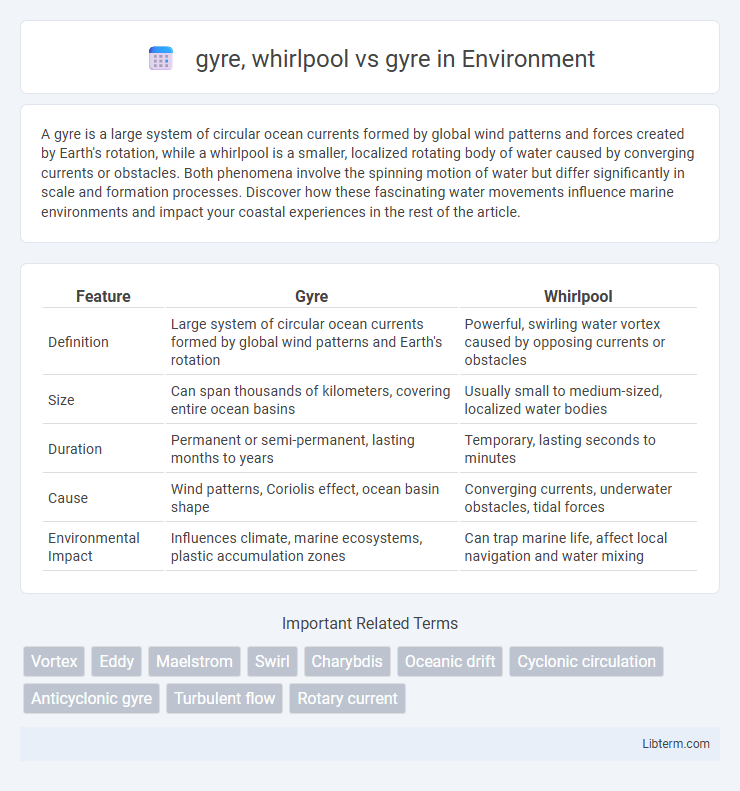A gyre is a large system of circular ocean currents formed by global wind patterns and forces created by Earth's rotation, while a whirlpool is a smaller, localized rotating body of water caused by converging currents or obstacles. Both phenomena involve the spinning motion of water but differ significantly in scale and formation processes. Discover how these fascinating water movements influence marine environments and impact your coastal experiences in the rest of the article.
Table of Comparison
| Feature | Gyre | Whirlpool |
|---|---|---|
| Definition | Large system of circular ocean currents formed by global wind patterns and Earth's rotation | Powerful, swirling water vortex caused by opposing currents or obstacles |
| Size | Can span thousands of kilometers, covering entire ocean basins | Usually small to medium-sized, localized water bodies |
| Duration | Permanent or semi-permanent, lasting months to years | Temporary, lasting seconds to minutes |
| Cause | Wind patterns, Coriolis effect, ocean basin shape | Converging currents, underwater obstacles, tidal forces |
| Environmental Impact | Influences climate, marine ecosystems, plastic accumulation zones | Can trap marine life, affect local navigation and water mixing |
Introduction to Gyres and Whirlpools
Gyres are large system-wide ocean currents formed by global wind patterns and Earth's rotation, circulating vast water masses across ocean basins. Whirlpools are smaller, localized, circular water movements caused by opposing currents or obstacles, resulting in intense rotational flow. Both phenomena influence marine navigation and ecosystems but differ significantly in scale and formation dynamics.
Defining a Gyre: What Is It?
A gyre is a large system of circular ocean currents formed by global wind patterns and forces created by Earth's rotation, primarily found in major ocean basins like the North Atlantic and Pacific. Unlike a whirlpool, which is a localized, often temporary spiral of water caused by opposing currents or obstacles, a gyre spans thousands of kilometers and plays a crucial role in regulating climate and marine ecosystems by distributing heat and nutrients. Understanding gyres involves analyzing their persistent, large-scale circulation patterns that influence oceanic and atmospheric processes worldwide.
Understanding Whirlpools: Characteristics and Formation
Whirlpools are intense, localized water vortices created by opposing currents or obstacles disrupting fluid flow, often found in narrow straits or river bends. They exhibit rapid, circular water movement and can pose navigational hazards, with sizes ranging from small eddies to massive, powerful swirls like the Moskstraumen in Norway. Unlike gyres, which are large-scale oceanic circulation patterns driven by global wind systems and Earth's rotation, whirlpools form from localized hydrodynamic conditions causing concentrated rotational water motion.
Key Differences Between Gyres and Whirlpools
Gyres are large systems of circular ocean currents formed by global wind patterns and Earth's rotation, spanning thousands of kilometers and influencing climate and marine ecosystems. Whirlpools are localized, vortex-like water movements caused by opposing currents or obstacles, typically much smaller in scale and duration compared to gyres. Unlike gyres that drive major ocean circulation, whirlpools represent rapid, spinning water phenomena with limited spatial impact.
Types of Gyres in the World’s Oceans
Gyres, large systems of circulating ocean currents, contrast with whirlpools, which are localized, spinning water phenomena. There are five major types of gyres in the world's oceans: the North Atlantic Gyre, South Atlantic Gyre, North Pacific Gyre, South Pacific Gyre, and Indian Ocean Gyre. Each gyre plays a critical role in regulating climate, marine biodiversity, and the global distribution of nutrients by driving currents such as the Gulf Stream and the Kuroshio Current.
Famous Examples of Whirlpools
Famous whirlpools such as the Maelstrom in Norway and the Naruto Whirlpools in Japan showcase powerful, localized water vortices caused by the tidal movements in narrow straits. Unlike broad, slow-moving ocean gyres that circulate vast areas of ocean water driven by global wind patterns and Coriolis forces, whirlpools are intense, rapidly rotating water masses typically found in confined locations. These natural phenomena demonstrate distinct hydrodynamic behaviors essential for understanding marine navigation and oceanographic study.
The Role of Gyres in Ocean Circulation
Gyres are large systems of circular ocean currents formed by global wind patterns and forces created by Earth's rotation, playing a crucial role in regulating climate and distributing heat across the planet. Unlike localized whirlpools, which are small, intense water vortices, gyres influence vast ocean circulation patterns that affect nutrient transport and marine ecosystems. Key gyres such as the North Atlantic Gyre and the Pacific Gyre drive thermohaline circulation, helping to balance ocean salinity and temperature.
Environmental Impact: Gyres vs Whirlpools
Gyres, large systems of circulating ocean currents driven by global wind patterns, accumulate vast amounts of plastic pollution, creating extensive marine debris zones that severely harm marine life and ecosystems. Whirlpools, localized vortexes formed by opposing currents or tidal forces, primarily impact marine navigation and local aquatic organisms but do not contribute significantly to widespread environmental degradation. The environmental impact of gyres is profound due to their scale and persistence in trapping pollutants, whereas whirlpools result in short-term, localized disruptions without long-term ecological consequences.
Human Interaction and Hazards Involving Gyres and Whirlpools
Human interaction with gyres and whirlpools involves significant hazards due to the powerful water movements that can trap vessels and swimmers. Gyres, large-scale ocean currents caused by global wind patterns and Earth's rotation, influence marine navigation and pollution dispersion, posing subtle but pervasive risks to shipping and coastal communities. Whirlpools, intense localized water vortices, create immediate dangers such as capsizing boats or pulling swimmers underwater, necessitating caution in high-risk areas for safety and rescue operations.
Conclusion: Gyres and Whirlpools in Perspective
Gyres are large-scale oceanic circulation patterns driven by global wind systems and the Coriolis effect, playing a crucial role in climate regulation and marine ecosystem productivity. In contrast, whirlpools are localized, powerful water vortices formed by opposing currents or obstacles, often posing navigation hazards but lacking the vast influence of gyres. Understanding the distinct dynamics and impacts of gyres versus whirlpools emphasizes the importance of gyres in large-scale ocean circulation and global environmental stability.
gyre, whirlpool Infographic

 libterm.com
libterm.com